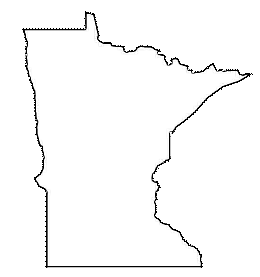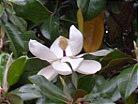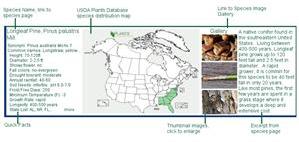








Minnesota
Home>Browse by State>Minnesota
Land of 10,000 Lakes, 'Star of the North'
State Tree: Red Pine
|
|
|
|
|
| A-Z scientific | ||
| A-Z by Common Name | ||
| Families | ||
| Browse by State | ||
| Rare or Endangered Species | ||
| Trees_with_Special_Uses | ||
| Tallest and Biggest |
| Aceraceae Maple Family | ||
| Anacardiaceae Sumac Family | ||
| Annonaceae Custard Apple Family | ||
| Aquifoliaceae Holly Family | ||
| Arecaceae, Palm Family | ||
| Betulaceae Birch family | ||
| Bignoniaceae Trumpet Creeper Family | ||
| Burseraceae Frankincense Family | ||
| Caprifoliaceae Honeysuckle Family | ||
| Chrysobalanaceae Coco-plum Family | ||
| Cornaceae Dogwood Family | ||
| Cupressaceae Cypress Family | ||
| Cyrillaceae Cyrilla Family | ||
| Ebenaceae Ebony Family | ||
| Ericaceae Heath Family | ||
| Fabaceae Pea Family | ||
| Fagaceae Beech Family | ||
| Hamamelidaceae Witch Hazel Ffamily | ||
| Hippocastanaceae Horse Chestnut Family | ||
| Juglandaceae Walnut Family | ||
| Lauraceae Laurel Family | ||
| Leitneriaceae Corkwood Family | ||
| Magnoliaceae Magnolia Family | ||
| Meliaceae Mahogany Family | ||
| Moraceae Mulberry Family | ||
| Myricaceae Bayberry Family | ||
| Myrsinaceae Myrsine Family | ||
| Myrtaceae Myrtle Family | ||
| Nyctaginaceae Four Oclock Family | ||
| Olacaceae Olax Family | ||
| Oleaceae Olive Family | ||
| Pinaceae Pine Family | ||
| Platanaceae Plane Tree Family | ||
| Polygonaceae Buckwheat Family | ||
| Rhamnaceae Buckthorn Family | ||
| Rosaceae Rose Family | ||
| Rubiaceae Madder Family | ||
| Rutaceae Rue Family | ||
| Salicaceae Willow Family | ||
| Sapindaceae Soapberry Family | ||
| Sapotaceae Sapodilla Family | ||
| Simaroubaceae Quassia Family | ||
| Styracaceae Storax Family | ||
| Symplocaceae Sweetleaf Family | ||
| Theaceae Tea Family | ||
| Tiliaceae Lindon Family | ||
| Ulmaceae Elm Family | ||
| Taxaceae Yew Family | ||
| Yucca Family |
| Maple A-Z |
| sumac_family_a-z |
| custard_apple_family_a-z |
| holly_trees_a-z |
| palm_family_a-z |
| birch_family_a-z |
| trumpet_creeper_family_a-z |
| honeysuckle_family_a-z |
| dogwood_family_a-z |
| cypress_family_a-z |
| heath_family_a-z |
| pea_family_a-z |
| beech_family_a-z |
| walnut_family_a-z |
| magnolia_family_a-z |
| olive_family_a-z |
| rose_family_a-z |
| willow_family_a-z |
| franklinia |
| elm_family_a-z |
| Federal List | ||
| State Lists | ||
| Invasive_species |
| Restoration of the American Chestnut | ||
| Restoration of the American Elm | ||
| Sustainable Forestry |
| Contact Us | ||
| Our Contributors | ||
| Photo of the Month | ||
| Usage Requirements | ||
| FAQ | ||
| Report a Broken Link |
| photo_submission |
| Photo Store |


™

Sunday, May 25, 2025

Want to add your tree to our picture gallery? Click here for details!
-Color denotes a tree that is rare or endangered

We are part of the Hubpages community.
Click here for more info.
Click here for more info.
Native Trees of Minnesota

Custom Search
Tree lists:
•A-Z by scientific
name
•A-Z by common
name
•By Family
For state A-Z list click state name below.
•A-Z by scientific
name
•A-Z by common
name
•By Family
For state A-Z list click state name below.

Minnesota is home to 52 native tree
species, mostly deciduous, and is also home to the largest stand of red pine in the United States. Some of the conifers in the northern regions of the state, such as balsam fir and white spruce, can withstand extreme cold. Quaking aspen, which gets its name from the way the leaves appear to quake or tremble with even the slightest breeze, is also able to tolerate even the coldest days in Minnesota. In the fall, brilliant reds, oranges, and yellows of various maple, oak, and hickory species add to the beauty of the diverse forests.
species, mostly deciduous, and is also home to the largest stand of red pine in the United States. Some of the conifers in the northern regions of the state, such as balsam fir and white spruce, can withstand extreme cold. Quaking aspen, which gets its name from the way the leaves appear to quake or tremble with even the slightest breeze, is also able to tolerate even the coldest days in Minnesota. In the fall, brilliant reds, oranges, and yellows of various maple, oak, and hickory species add to the beauty of the diverse forests.
While visiting southern Minnesota, you may stumble upon an increasingly rare oak forest comprised of bur and black oaks, pignut and bitternut hickories, and possibly paper birch or aspen. Heading north, conifers become more and more prevalent with white pine forests on slopes and near various water sources and red or jack pines preferring drier sites. In addition to pine forests in the north, spruce forests including balsam fir, white spruce and cedar may be found. The area around the northern shoreline of Lake Superior in particular, is home to plentiful white cedar forests.
There are also lowland hardwood forests throughout the state, although forest composition changes from north to south along the steams and rivers. Ash, elm, and maples dominate the lowland forests but they may include white cedar and balsam fir in the northern reaches of the state.
There are also lowland hardwood forests throughout the state, although forest composition changes from north to south along the steams and rivers. Ash, elm, and maples dominate the lowland forests but they may include white cedar and balsam fir in the northern reaches of the state.
Minnesota Native Tree Facts
Forested acres: 17.3 million
Percent of total area forested: 53%
Predominant Forest Type(s): Northern MN- northern hardwood, sugar maple-basswood
Number of National Forests: 3
Number of State Forests: 58
Number of Tree city USA communities: 120
Number of invasive tree species: 7 (see state list for noxious/invasive plants)
Insects of Concern: Emerald Ash Borer, Gypsy Moth, Two-lined Chestnut Borer, Forest Tent Catepillar, Pine Bark Beetle
Pathogens of Concern: Oak Wilt
Number or Rare, Threatened or Endangered Species: 4
Number of tree families in our collection: 25
Sources:
Arborday.org
US Forest Service
Minnesota Department of Natural Resources
United States Department Of Agriculture, Natural Resources Conservation Services: PLANTS Database
Additional state resources:
Minnesota State Parks
University of Minnesota Extension Service
Percent of total area forested: 53%
Predominant Forest Type(s): Northern MN- northern hardwood, sugar maple-basswood
Number of National Forests: 3
Number of State Forests: 58
Number of Tree city USA communities: 120
Number of invasive tree species: 7 (see state list for noxious/invasive plants)
Insects of Concern: Emerald Ash Borer, Gypsy Moth, Two-lined Chestnut Borer, Forest Tent Catepillar, Pine Bark Beetle
Pathogens of Concern: Oak Wilt
Number or Rare, Threatened or Endangered Species: 4
Number of tree families in our collection: 25
Sources:
Arborday.org
US Forest Service
Minnesota Department of Natural Resources
United States Department Of Agriculture, Natural Resources Conservation Services: PLANTS Database
Additional state resources:
Minnesota State Parks
University of Minnesota Extension Service
Minnesota Native Tree Families and Genera
Useful information while browsing species:
• How to read a botanical name
• How to use our species boxes:
• How to read a botanical name
• How to use our species boxes:
Additional Resources:
North American Native Tree Families
North American A to Z List by Scientific Name
North American A to Z List by Common Name
North American Native Tree Families
North American A to Z List by Scientific Name
North American A to Z List by Common Name
click to enlarge.
-Color denotes a tree that is rare or endangered

Please note: This is not a complete list of all native tree families and species found in Massachusetts. We are constantly working towards a more comprehensive list and will add families and their species as completed.
Follow the links to view species native to Massachusetts. If the genus is not linked, species are listed on the family page.
Aceraceae, Maple
Anacardiaceae, Sumac
Rhus, Sumac
Toxicodendron, Poison Sumac
Betulaceae, Birch
Betula, Birch
Carpinus, Hornbeam
Corylus, Hazelnut
Ostrya, Hophornbeam
Bignoniaceae, Trumpet Creeper
Caprifoliaceae, Honeysuckle
Cornaceae, Dogwood
Cornus, Dogwood
Nyssa, Tupelo
Aceraceae, Maple
Anacardiaceae, Sumac
Rhus, Sumac
Toxicodendron, Poison Sumac
Betulaceae, Birch
Betula, Birch
Carpinus, Hornbeam
Corylus, Hazelnut
Ostrya, Hophornbeam
Bignoniaceae, Trumpet Creeper
Caprifoliaceae, Honeysuckle
Cornaceae, Dogwood
Cornus, Dogwood
Nyssa, Tupelo
Cupressaceae- Cypress
Juniperus, Juniper
Thuja, Arborvitae
Fabaceae, Pea
Gleditsia, Locust
Fagaceae, Beech
Quercus, Oak
Hamamelidaceae, Witch-hazel
Hippocastanaceae, Horse-chestnut
Juglandaceae, Walnut
Carya, Hickory
Juglans, Walnut
Moraceae, Mulberry
Morus, Mulberry
Oleaceae, Olive
Fraxinus, Ash
Juniperus, Juniper
Thuja, Arborvitae
Fabaceae, Pea
Gleditsia, Locust
Fagaceae, Beech
Quercus, Oak
Hamamelidaceae, Witch-hazel
Hippocastanaceae, Horse-chestnut
Juglandaceae, Walnut
Carya, Hickory
Juglans, Walnut
Moraceae, Mulberry
Morus, Mulberry
Oleaceae, Olive
Fraxinus, Ash
Pinaceae, Pinus
Abies, Fir
Pinus, Pine
Rosaceae, Rose
Crataegus, Hawthorn
Rubiaceae, Madder
Rutaceae, Rue
Salicaceae, Willow
Populus, Cottonwood
Salix, Willow
Tiliaceae, Lindon
Tilia, Basswood
Ulmaceae, Elm
Celtis, Hackberry
Ulmus, Elm
Abies, Fir
Pinus, Pine
Rosaceae, Rose
Crataegus, Hawthorn
Rubiaceae, Madder
Rutaceae, Rue
Salicaceae, Willow
Populus, Cottonwood
Salix, Willow
Tiliaceae, Lindon
Tilia, Basswood
Ulmaceae, Elm
Celtis, Hackberry
Ulmus, Elm
Minnesota Endangered or Threatened Tree Species
Native plant species considered rare in Minnesota meet one or
more of the following state categories based on biological
research and/or inventory:
• Threatened- T- any species which is likely to become an endangered
species within the foreseeable future throughout all or a significant portion
of its range.
Additional Resources:
North American Rare and Endangered Trees
External Links:
USDA PLANTS Database
Full Minnesota Rare Plant List
North American Rare and Endangered Trees
External Links:
USDA PLANTS Database
Full Minnesota Rare Plant List
• Endangered- E- any species of fish, plant life, or wildlife that is in danger of extinction throughout all or a significant part of its
range, other than a species of insecta determined by the department or the secretary of the United States department of the interior
to constitute a pest whose protection under this part would present an overwhelming and overriding risk to humans.
Tree species with status present in Minnesota (see related links for full list):
Special Concern:
Juglans cinerea- Butternut
Salix pellita- Satiny Willow
Tsuga canadensis- Eastern Hemlock
Threatened:
Crataegus douglasii- Black Hawthorn
Endangered:
No tree species with this classification
No tree species with this classification
Looking for a nursery near you?
Check out our nursery listing by county below!
Sorry, we do not currently have any tree nursery listings for this state. We do update these lists, so please check back.
Check out our nursery listing by county below!
Sorry, we do not currently have any tree nursery listings for this state. We do update these lists, so please check back.






Also called Norway pine, Pinus resinosa was adopted as the state tree of Minnesota in 1953 and is a dominant tree from the Twin Cities all the way north to the Canadian border. Once more bountiful in pre-colonial times, as of 1990, there were still around 300,000 acres state wide of red pine with the largest remaining stand found in Itasca State park. The common name Norway pine was bestowed by early settlers from Norway who thought the tree resembled pine species back home while it is more widely referred to as red pine due to the tree's reddish wood and bark.
A native conifer, Pinus resinosa, averages between 75 and 80 feet but may grow to 200 feet in optimal sites. The largest trunk d.b.h (diameter at breast height) on record is 59.6 inches but the trunk base typically only reaches widths of 2 to 3 feet. Red pines have a single stem, or trunk, that supports a symmetrical, dense and oval crown that is supported by up curved branches. Twigs and branches are yellowish brown when young but turn reddish orange-brown. Red pine produces a new whorl of branches each year and grows in height at a rate of 10 inches per year for about 60 years. The bark is distinguished by the diamond, or criss-crossed, plate pattern created by fissures in the surface. It is a rich, warm, reddish-brown and has thin, scaly plates. Read more
A native conifer, Pinus resinosa, averages between 75 and 80 feet but may grow to 200 feet in optimal sites. The largest trunk d.b.h (diameter at breast height) on record is 59.6 inches but the trunk base typically only reaches widths of 2 to 3 feet. Red pines have a single stem, or trunk, that supports a symmetrical, dense and oval crown that is supported by up curved branches. Twigs and branches are yellowish brown when young but turn reddish orange-brown. Red pine produces a new whorl of branches each year and grows in height at a rate of 10 inches per year for about 60 years. The bark is distinguished by the diamond, or criss-crossed, plate pattern created by fissures in the surface. It is a rich, warm, reddish-brown and has thin, scaly plates. Read more




